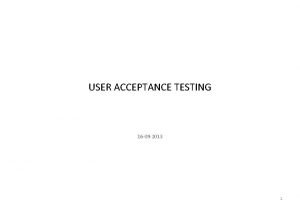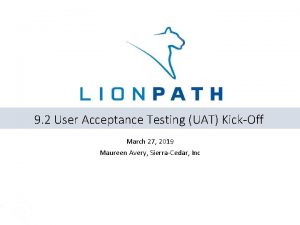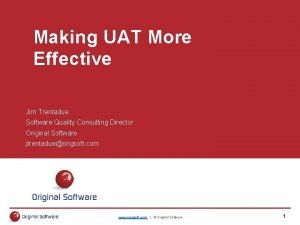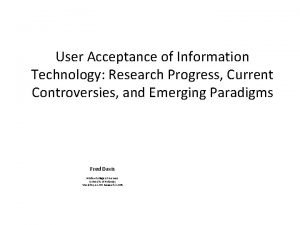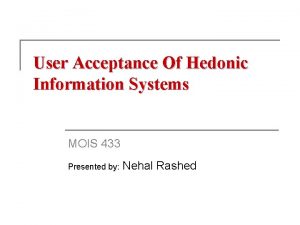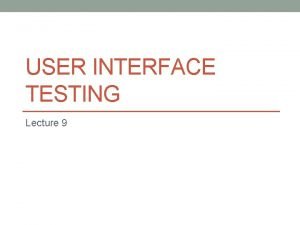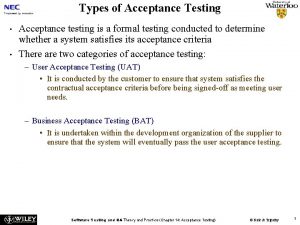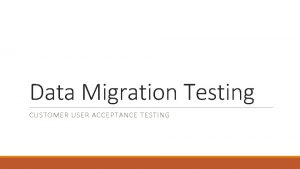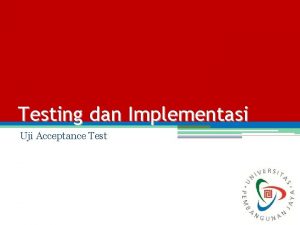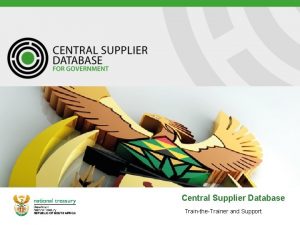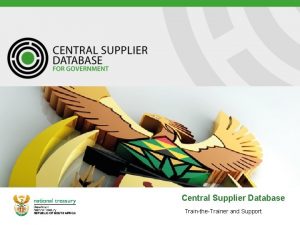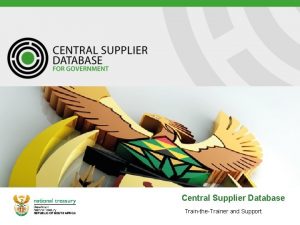User Acceptance Testing What is it and why












- Slides: 12

User Acceptance Testing What is it and why is it important? Jonathan Snape – Team Leader e. PMA UHNM

UHNM – e. PMA status. - 1400 bed acute Trust over 2 sites - Tertiary referral centre for West Midlands, Cheshire, Shropshire and Staffordshire. - Working with Noemalife to configure Galileo e. PMA for roll-out starting March 2015. - Will be the first UK site to operate Galileo. - Roll-out plan for all clinical areas including critical care, child health and outpatients over next 18 months.

Testing approach • Test environment • Testers with relevant /current practice • Test plan

User Acceptance Testing (UAT) • Formal definition (ISTQB): “Formal testing with respect to user needs, requirements and business processes conducted to determine whether or not a system satisfies the acceptance criteria and to enable the user, customers or other authorised entity to determine whether or not to accept the system. ”

What does UAT actually mean to us? • User Real system users – our staff (pharmacists / nurses / prescribers / ICT / AHP’s) • Acceptance Confidence that the Trust will benefit from the system as configured. Not just about meeting the technical spec – need to consider real world usability • Testing Will the system work in acute clinical practice in a variety of clinical specialties?

Our approach to UAT • Test plan – what and how to test • Real-life scenarios (test scripts / use cases) • Follow the journey from Medicines Reconciliation to Discharge. • Consider all roles

Our approach to UAT cont. …. • 20 test scenarios • 250+ medicines (from real Rx charts) • All routes, dose types, frequencies • Simple oral complex infusions • All user roles (technician, pharmacist, nurse, prescribers)

Our approach to UAT cont. …. • Scenarios include 3 rd party DSS (drug-drug / allergy /duplication) • Interfaces (e. Discharge / PAS / clinical portal - results) • Include hardware to be used at go-live

What do we do with the results? • Shared test log – editable in real time – UHNM / Noemalife • Visibility of supplier actions to deal with issue • Convenient forum for clarification / state of fix • Discuss best way forward / how to update environment • Re-test once deployed onto test environment • ‘No showstoppers’ after UAT should mean ‘No surprises at Go Live!”

Don’t fall into the trap of skipping full UAT 1) “The project is late” 2) “Staff can’t be spared” 3) “Staff don’t understand the system” 4) “We can fix that once we have gone live” (may be true for some issues) 5) “It’s a standard product – why should we be any different”

Why is UAT important ? • It might be linked to contractual milestones • Sign-off indicates the Trust has found the product has been delivered to their satisfaction • Next stop – clinical areas !!

Good luck and watch this space !
 User acceptance testing template
User acceptance testing template Uat sign off email template
Uat sign off email template Uat meaning
Uat meaning Hey hey bye bye
Hey hey bye bye User acceptance of information technology
User acceptance of information technology User acceptance of hedonic information systems
User acceptance of hedonic information systems Single user and multi user operating system
Single user and multi user operating system Multi user operating system
Multi user operating system Don't ask why why why
Don't ask why why why Positive vs negative testing
Positive vs negative testing Cs3250
Cs3250 Graphical user interface testing
Graphical user interface testing User testing software engineering
User testing software engineering
